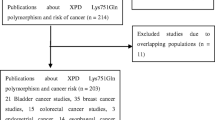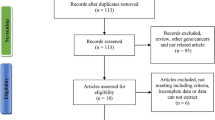Abstract
Numerous epidemiological studies have been conducted to investigate the association between Xeroderma pigmentosum complementation group D (XPD) Asp312Asn (rs1799793 G > A) and Lys751Gln (rs13181 A > C) polymorphisms and bladder cancer risk; however, the conclusions remain controversial. With this in mind, we performed this meta-analysis with 11 studies including 3,797 cases and 5,094 controls for Asp312Asn and 21 studies including 6,360 cases and 7,894 controls for Lys751Gln polymorphism. We searched available literatures from PubMed, Embase, and CBM databases. Crude odds ratios (ORs) and 95 % confidence intervals (CIs) were calculated to assess the strength of the associations. Moreover, to validate biological plausibility of our findings, the effects of these two polymorphisms on XPD gene expression within three ethnicities was determine by gene expression analysis based on imputed genotypes from HapMap. Overall, the variant allele of Asp312Asn polymorphism was associated with an increased risk of bladder cancer (Asn/Asn vs. Asp/Asp: OR = 1.51, 95 % CI = 1.19–1.91; Asp/Asn vs. Asp/Asp: OR = 1.23, 95 % CI = 1.12–1.35; recessive model: OR = 1.33, 95 % CI = 1.10–1.61; dominant model: OR = 1.32, 95 % CI = 1.14–1.52; and allele comparing: OR = 1.26, 95 % CI = 1.11–1.42). We found the Lys751Gln was associated with increased bladder cancer risk only under the recessive model (OR = 1.14, 95 % CI = 1.01–1.29). Stratification analyses demonstrated an increased risk for Asians and hospital-based studies under all genetic models while only under the dominant model for Caucasians as to the Asp312Asn polymorphism and for Caucasians under the recessive model as to the Lys751Gln polymorphism. We also found the Asp312Asn polymorphism can significantly influence mRNA expression levels among Asians and Caucasians, and the Lys751Gln polymorphism has a similar effect for Caucasians. Despite some limitations, this meta-analysis suggests that polymorphisms in XPD gene may contribute to bladder cancer susceptibility. These findings need further validation by large well-designed prospective studies.





Similar content being viewed by others
Abbreviations
- NER:
-
nucleotide excision repair
- SNP:
-
single nucleotide polymorphism
- DRC:
-
DNA repair capacity
- XPD:
-
Xeroderma pigmentosum complementation group D
- CBM:
-
Chinese Biomedical
- OR:
-
Odds ratio
- CI:
-
Confidence interval
- HWE:
-
Hardy–Weinberg equilibrium
References
Jemal A, Bray F, Center MM, Ferlay J, Ward E, et al. Global cancer statistics. CA Cancer J Clin. 2011;61:69–90.
Shields PG, Harris CC. Cancer risk and low-penetrance susceptibility genes in gene–environment interactions. J Clin Oncol. 2000;18:2309–15.
Parkin DM. The global health burden of infection-associated cancers in the year 2002. Int J Cancer. 2006;118:3030–44.
Wu X, Zhao H, Suk R, Christiani DC. Genetic susceptibility to tobacco-related cancer. Oncogene. 2004;23:6500–23.
Bosetti C, Pira E, La Vecchia C. Bladder cancer risk in painters: a review of the epidemiological evidence, 1989–2004. Cancer Causes Control. 2005;16:997–1008.
Friedberg EC. How nucleotide excision repair protects against cancer. Nat Rev Cancer. 2001;1:22–33.
Goode EL, Ulrich CM, Potter JD. Polymorphisms in DNA repair genes and associations with cancer risk. Cancer Epidemiol Biomarkers Prev. 2002;11:1513–30.
Lamerdin JE, Stilwagen SA, Ramirez MH, Stubbs L, Carrano AV. Sequence analysis of the ERCC2 gene regions in human, mouse, and hamster reveals three linked genes. Genomics. 1996;34:399–409.
Matullo G, Guarrera S, Carturan S, Peluso M, Malaveille C, et al. DNA repair gene polymorphisms, bulky DNA adducts in white blood cells and bladder cancer in a case–control study. Int J Cancer. 2001;92:562–7.
Stern MC, Johnson LR, Bell DA, Taylor JA. XPD codon 751 polymorphism, metabolism genes, smoking, and bladder cancer risk. Cancer Epidemiol Biomarkers Prev. 2002;11:1004–11.
Shen M, Hung RJ, Brennan P, Malaveille C, Donato F, et al. Polymorphisms of the DNA repair genes XRCC1, XRCC3, XPD, interaction with environmental exposures, and bladder cancer risk in a case–control study in northern Italy. Cancer Epidemiol Biomarkers Prev. 2003;12:1234–40.
Sanyal S, Festa F, Sakano S, Zhang Z, Steineck G, et al. Polymorphisms in DNA repair and metabolic genes in bladder cancer. Carcinogenesis. 2004;25:729–34.
Broberg K, Bjork J, Paulsson K, Hoglund M, Albin M. Constitutional short telomeres are strong genetic susceptibility markers for bladder cancer. Carcinogenesis. 2005;26:1263–71.
Matullo G, Guarrera S, Sacerdote C, Polidoro S, Davico L, et al. Polymorphisms/haplotypes in DNA repair genes and smoking: a bladder cancer case–control study. Cancer Epidemiol Biomarkers Prev. 2005;14:2569–78.
Schabath MB, Delclos GL, Grossman HB, Wang Y, Lerner SP, et al. Polymorphisms in XPD exons 10 and 23 and bladder cancer risk. Cancer Epidemiol Biomarkers Prev. 2005;14:878–84.
Andrew AS, Nelson HH, Kelsey KT, Moore JH, Meng AC, et al. Concordance of multiple analytical approaches demonstrates a complex relationship between DNA repair gene SNPs, smoking and bladder cancer susceptibility. Carcinogenesis. 2006;27:1030–7.
Garcia-Closas M, Malats N, Real FX, Welch R, Kogevinas M, et al. Genetic variation in the nucleotide excision repair pathway and bladder cancer risk. Cancer Epidemiol Biomarkers Prev. 2006;15:536–42.
Matullo G, Dunning AM, Guarrera S, Baynes C, Polidoro S, et al. DNA repair polymorphisms and cancer risk in non-smokers in a cohort study. Carcinogenesis. 2006;27:997–1007.
Wu X, Gu J, Grossman HB, Amos CI, Etzel C, et al. Bladder cancer predisposition: a multigenic approach to DNA-repair and cell–cycle–control genes. Am J Hum Genet. 2006;78:464–79.
Shao J, Gu M, Xu Z, Hu Q, Qian L. Polymorphisms of the DNA gene XPD and risk of bladder cancer in a Southeastern Chinese population. Cancer Genet Cytogenet. 2007;177:30–6.
Andrew AS, Karagas MR, Nelson HH, Guarrera S, Polidoro S, et al. DNA repair polymorphisms modify bladder cancer risk: a multi-factor analytic strategy. Hum Hered. 2008;65:105–18.
Covolo L, Placidi D, Gelatti U, Carta A, Scotto Di Carlo A, et al. Bladder cancer, GSTs, NAT1, NAT2, SULT1A1, XRCC1, XRCC3, XPD genetic polymorphisms and coffee consumption: a case–control study. Eur J Epidemiol. 2008;23:355–62.
Fontana L, Bosviel R, Delort L, Guy L, Chalabi N, et al. DNA repair gene ERCC2, XPC, XRCC1, XRCC3 polymorphisms and associations with bladder cancer risk in a French cohort. Anticancer Res. 2008;28:1853–6.
Chang CH, Wang RF, Tsai RY, Wu HC, Wang CH, et al. Significant association of XPD codon 312 single nucleotide polymorphism with bladder cancer susceptibility in Taiwan. Anticancer Res. 2009;29:3903–7.
Gangwar R, Ahirwar D, Mandhani A, Mittal RD. Influence of XPD and APE1 DNA repair gene polymorphism on bladder cancer susceptibility in north India. Urology. 2009;73:675–80.
Narter KF, Ergen A, Agachan B, Gormus U, Timirci O, et al. Bladder cancer and polymorphisms of DNA repair genes (XRCC1, XRCC3, XPD, XPG, APE1, hOGG1). Anticancer Res. 2009;29:1389–93.
Gao W, Romkes M, Zhong S, Nukui T, Persad RA, et al. Genetic polymorphisms in the DNA repair genes XPD and XRCC1, p53 gene mutations and bladder cancer risk. Oncol Rep. 2010;24:257–62.
Rouissi K, Bahria IB, Bougatef K, Marrakchi R, Stambouli N, et al. The effect of tobacco, XPC, ERCC2 and ERCC5 genetic variants in bladder cancer development. BMC Cancer. 2011;11:101.
Wang YH, Yeh SD, Shen KH, Shen CH, Tung MC, et al. Association of hOGG1 and XPD polymorphisms with urothelial carcinoma in Taiwan. Anticancer Res. 2011;31:3939–44.
Mittal RD, Mandal RK. Genetic variation in nucleotide excision repair pathway genes influence prostate and bladder cancer susceptibility in North Indian population. Indian J Hum Genet. 2012;18:47–55.
Sobti RC, Kaur S, Sharma VL, Singh SK, Hosseini SA, et al. Susceptibility of XPD and RAD51 genetic variants to carcinoma of urinary bladder in North Indian population. DNA Cell Biol. 2012;31:199–210.
Chen M, Kamat AM, Huang M, Grossman HB, Dinney CP, et al. High-order interactions among genetic polymorphisms in nucleotide excision repair pathway genes and smoking in modulating bladder cancer risk. Carcinogenesis. 2007;28:2160–5.
Andrew AS, Mason RA, Kelsey KT, Schned AR, Marsit CJ, et al. DNA repair genotype interacts with arsenic exposure to increase bladder cancer risk. Toxicol Lett. 2009;187:10–4.
Ricceri F, Guarrera S, Sacerdote C, Polidoro S, Allione A, et al. ERCC1 haplotypes modify bladder cancer risk: a case–control study. DNA Repair (Amst). 2010;9:191–200.
Rouissi K, Ouerhani S, Hamrita B, Bougatef K, Marrakchi R, et al. Smoking and polymorphisms in xenobiotic metabolism and DNA repair genes are additive risk factors affecting bladder cancer in Northern Tunisia. Pathol Oncol Res. 2011;17:879–86.
He J, Qiu LX, Wang MY, Hua RX, Zhang RX, et al. Polymorphisms in the XPG gene and risk of gastric cancer in Chinese populations. Hum Genet. 2012;131:1235–44.
He J, Shi TY, Zhu ML, Wang MY, Li QX, et al. Associations of Lys939Gln and Ala499Val polymorphisms of the XPC gene with cancer susceptibility: a meta-analysis. Int J Cancer. 2013;133:1765–75.
Shi TY, Cheng X, Yu KD, Sun MH, Shao ZM, et al. Functional variants in TNFAIP8 associated with cervical cancer susceptibility and clinical outcomes. Carcinogenesis. 2013;34:770–8.
Mantel N, Haenszel W. Statistical aspects of the analysis of data from retrospective studies of disease. J Natl Cancer Inst. 1959;22:719–48.
DerSimonian R, Laird N. Meta-analysis in clinical trials. Control Clin Trials. 1986;7:177–88.
Egger M, Davey Smith G, Schneider M, Minder C. Bias in meta-analysis detected by a simple, graphical test. BMJ. 1997;315:629–34.
Wang M, Gu D, Zhang Z, Zhou J. XPD polymorphisms, cigarette smoking, and bladder cancer risk: a meta-analysis. J Toxicol Environ Health A. 2009;72:698–705.
Li C, Jiang Z, Liu X. XPD Lys(751)Gln and Asp (312)Asn polymorphisms and bladder cancer risk: a meta-analysis. Mol Biol Rep. 2010;37:301–9.
Weber CA, Salazar EP, Stewart SA, Thompson LH. Molecular cloning and biological characterization of a human gene, ERCC2, that corrects the nucleotide excision repair defect in CHO UV5 cells. Mol Cell Biol. 1988;8:1137–46.
Wang XW, Vermeulen W, Coursen JD, Gibson M, Lupold SE, et al. The XPB and XPD DNA helicases are components of the p53-mediated apoptosis pathway. Genes Dev. 1996;10:1219–32.
Lehmann AR. The xeroderma pigmentosum group D (XPD) gene: one gene, two functions, three diseases. Genes Dev. 2001;15:15–23.
Dai QS, Hua RX, Zeng RF, Long JT, Peng ZW. XPC gene polymorphisms contribute to bladder cancer susceptibility: a meta-analysis. Tumour Biol. 2013. doi:10.1007/s13277-013-1062-y.
Shen MR, Jones IM, Mohrenweiser H. Nonconservative amino acid substitution variants exist at polymorphic frequency in DNA repair genes in healthy humans. Cancer Res. 1998;58:604–8.
Acknowledgments
This work was supported by a grant funded by Heilongjiang Education Department of China (1252HQ016).
Conflicts of interest
None
Author information
Authors and Affiliations
Corresponding authors
Additional information
Li and Dai contributed equally to this study and should be considered as co-first authors.
Rights and permissions
About this article
Cite this article
Li, SX., Dai, QS., Chen, SX. et al. Xeroderma pigmentosum complementation group D (XPD) gene polymorphisms contribute to bladder cancer risk: a meta-analysis. Tumor Biol. 35, 3905–3915 (2014). https://doi.org/10.1007/s13277-013-1519-z
Received:
Accepted:
Published:
Issue Date:
DOI: https://doi.org/10.1007/s13277-013-1519-z




